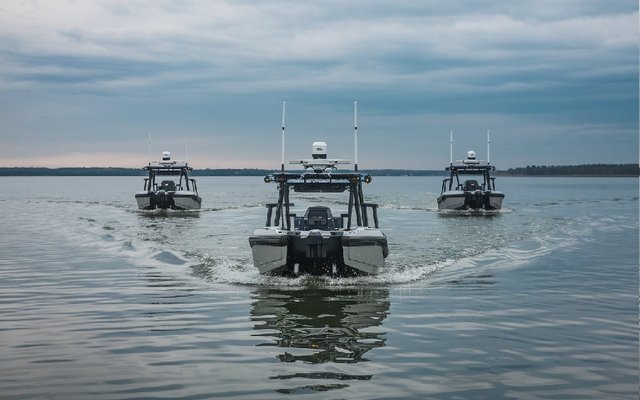
The Autonomous Boats Market is set for significant growth, with a projected increase from USD 558 million in 2024 to USD 872 million by 2029, reflecting a Compound Annual Growth Rate (CAGR) of 9.3%. This expansion is largely driven by advancements in artificial intelligence, sensor technologies, and the Internet of Things (IoT), all of which are enhancing the sustainability, safety, and efficiency of maritime operations. Key Players such as Kongsberg Maritime (Norway), ABB (Switzerland), and Rolls-Royce PLC (UK) are at the forefront of this revolution, leveraging cutting-edge technology to meet the rising demand for automation across various sectors, including commercial, recreational, and military applications.
Market Drivers and Opportunities
A primary driver of Autonomous Boats Industry growth is the increasing adoption of automated systems to minimize human errors and enhance operational safety. Autonomous boats, equipped with AI, machine learning, and advanced sensors, are capable of executing precise and reliable maritime operations, which significantly reduces the likelihood of human error. These technological advancements also improve navigation and decision-making, especially in complex marine environments. Automation also offers economic benefits, such as lower operating costs and enhanced safety, making it an attractive solution for the commercial, industrial, and defense sectors.
Sensor technology continues to evolve, offering improved navigation capabilities. High-resolution radar, LiDAR, and advanced SONAR systems are enabling autonomous vessels to navigate with greater accuracy, avoiding obstacles and making real-time adjustments. These developments are unlocking new opportunities in the market, particularly for applications in maritime surveying and urban mobility.
You Can Download Our PDF Brochure: https://www.marketsandmarkets.com/pdfdownloadNew.asp?id=222340429
Market Restraints and Challenges
Despite its potential, the autonomous boats market faces significant challenges, including cybersecurity threats. The reliance on digital systems makes autonomous vessels vulnerable to cyberattacks that could disrupt operations, compromise sensitive data, or even cause physical harm. This vulnerability necessitates the development of robust cybersecurity protocols, which may increase production and operational costs, thus potentially slowing market growth.
Another challenge is the cost-intensive customization required for marine automation systems. Tailoring these systems to meet specific regulatory and operational needs can be expensive, which may deter smaller operators from entering the market. Additionally, ongoing maintenance, software updates, and support services contribute to these costs, limiting scalability for some manufacturers and users.
Key Market Segments
The market is divided into several key segments, including recreational, commercial, and military boats. The recreational segment is expected to see the highest growth rate, driven by consumer demand for advanced technology that enhances safety and ease of use. Autonomous recreational boats offer extended navigation, automated docking, and improved handling, making them
attractive to enthusiasts seeking cutting-edge recreational experiences.
In terms of propulsion, fuel-powered boats are projected to hold the largest market share during the forecast period. These systems are known for their reliability and are increasingly integrated with autonomous technologies to optimize performance. Hybrid and fully electric propulsion systems are also gaining traction, driven by environmental concerns and the push for more sustainable solutions.
Regarding boat size, vessels in the 20–40 feet range are expected to dominate the market. This size range is versatile and widely applicable across recreational, commercial, and governmental operations, making it a popular choice for a variety of autonomous applications. The ease of integrating autonomous systems into this category further supports its expected growth.
The autonomy segment is divided into partially autonomous, remotely operated, and fully autonomous vessels. Partially autonomous boats, which can operate independently while requiring minimal human intervention, are expected to command the largest market share. These boats are favored for their balance of efficiency, safety, and lower operational costs, particularly in research and surveillance operations.
Regional Outlook
Europe is expected to lead the autonomous boats market, holding the largest share by 2024. The region benefits from a robust maritime industry, advanced technological infrastructure, and stringent environmental regulations that encourage the adoption of autonomous technologies. High levels of investment in research and development, supported by both public and private sectors, further drive innovation in the region.
To Gain Deeper Insights Into This Dynamic Market, Speak to Our Analyst Here: https://www.marketsandmarkets.com/speaktoanalystNew.asp?id=222340429
Key Players and Recent Developments
Major players in the market include Kongsberg Maritime (Norway), ABB (Switzerland), Rolls-Royce PLC (UK), Hyundai Heavy Industries (South Korea), and Fugro (Netherlands). Recent developments highlight the growing collaboration between technology providers and shipbuilders to advance autonomous capabilities. For example, Rolls-Royce partnered with Sea Machines to develop smart and autonomous ship control systems, while Hyundai’s venture Avikus signed a memorandum of understanding with ABS to integrate autonomous technologies into commercial vessels.
As sensor technology, AI, and cybersecurity solutions continue to advance, the autonomous boats market is poised for rapid growth. The increasing demand for automation in both commercial and defense sectors, combined with technological advancements, is expected to drive this market forward, making autonomous boats a key component of the future maritime landscape.